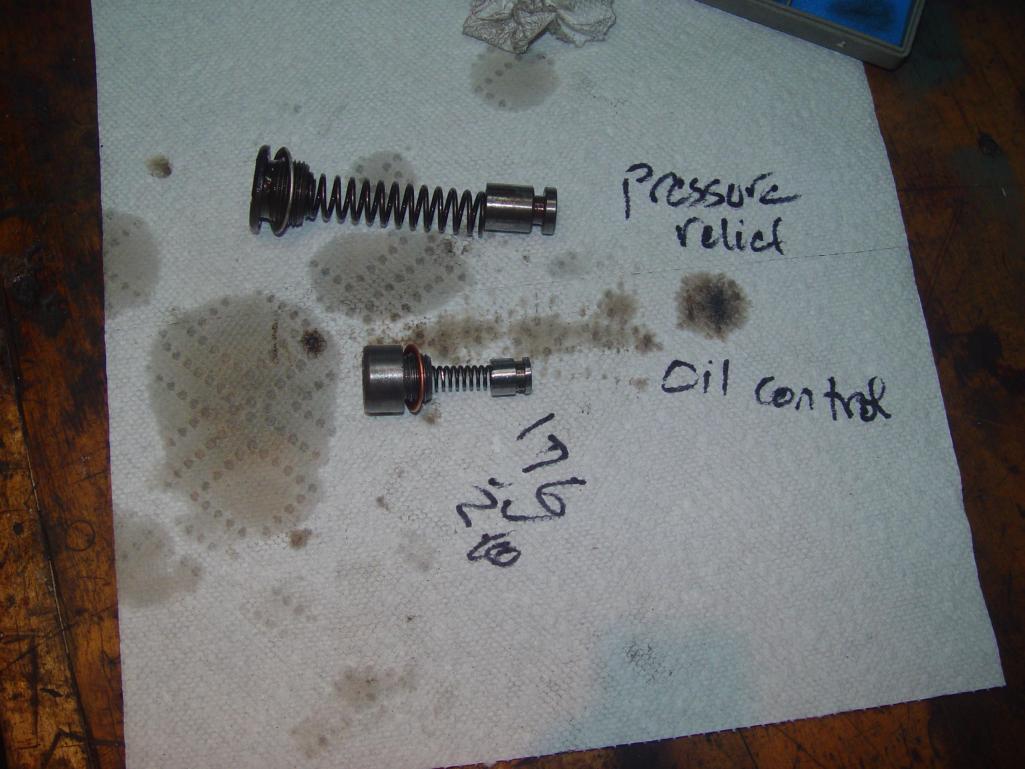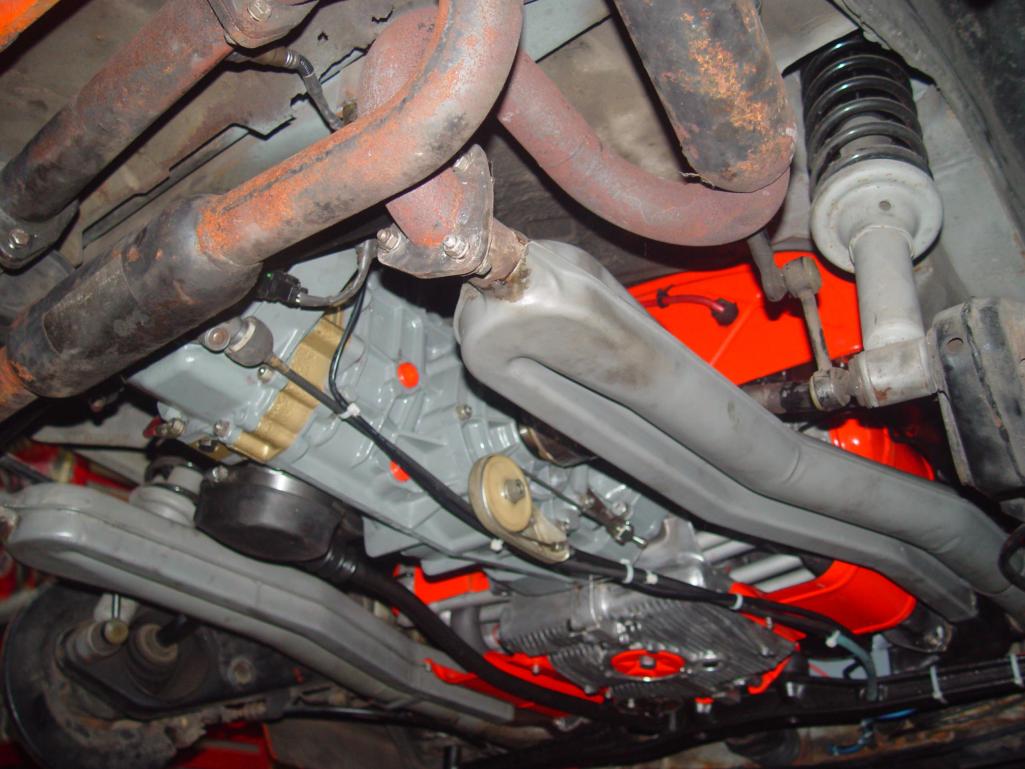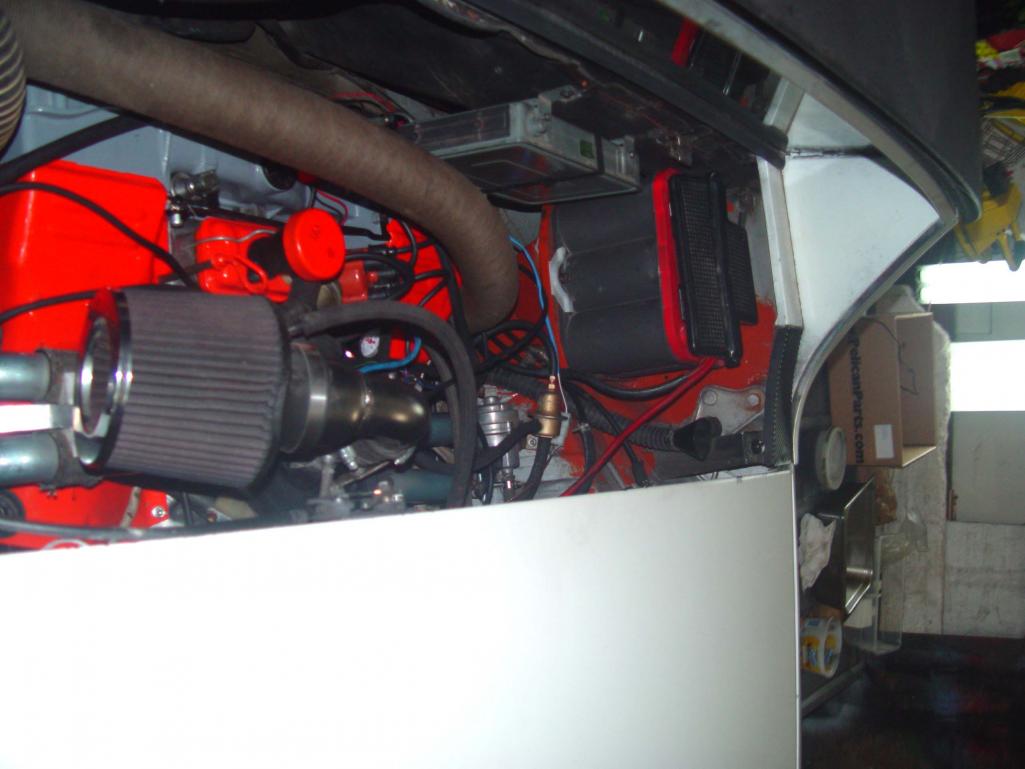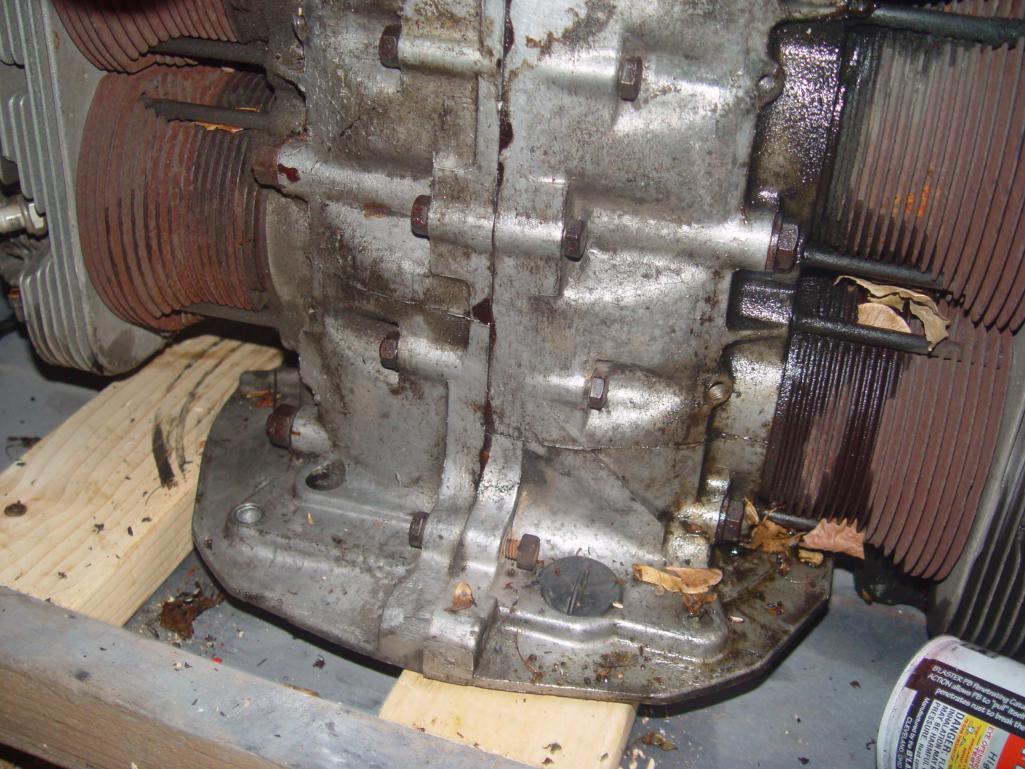|
|

|
Porsche, and the Porsche crest are registered trademarks of Dr. Ing. h.c. F. Porsche AG.
This site is not affiliated with Porsche in any way. Its only purpose is to provide an online forum for car enthusiasts. All other trademarks are property of their respective owners. |
|
|
  |
| McMark |
 Apr 27 2013, 12:00 AM Apr 27 2013, 12:00 AM
Post
#21
|
|
914 Freak!                Group: Retired Admin Posts: 20,179 Joined: 13-March 03 From: Grand Rapids, MI Member No.: 419 Region Association: None |
Good point Mike! Try some Brad Penn 20-50.
|
| brant |
 Apr 27 2013, 06:53 AM Apr 27 2013, 06:53 AM
Post
#22
|
|
914 Wizard           Group: Members Posts: 11,632 Joined: 30-December 02 From: Colorado Member No.: 47 Region Association: Rocky Mountains 

|
before you pull the motor, I think I would go through the oil pressure relief pistons.
used should be fine if there was no scarring on the pistons or bores. you can unscrew the lower plug and only a little oil will drip out. clean the bore with some carb cleaner or starting fluid when its done dripping re-insert the piston and make sure it is smooth in the bore visually inspect the sealing face with a flash light inside of the bore/case then get some bluing compound and test the sealing face if there is any roughness or damage to the sealing face you can also take some valve grinding compound and use the piston to re-machine that face if it comes to that you will also need to replace the piston I've done it once by using a dowel rod on the old piston and turning the old piston for 10-15 minutes to re-machine the face back to smooth. I know this is likely not your problem but its worth checking since you don't have to pull the motor to do so I wouldn't break in with synthetic but that is only for the rings concern there is no reason synthetic would give you a lower oil pressure any size of rebuilt oil pump should still give you good pressure I don't know if your running a front remote cooler, but your pump should be sized plenty big the way you are.. you can tripple check your oil pressure by changing out to a mechanical gauge temporarily.... I did it when I was in your situation only because I really didn't want to rebuild the motor again.... it didn't change anything for my situation but most of the rest of the fixes require tearing the motor out. you can pull the pump after pulling the motor and at least inspect it carefully before going deeper. I'm sorry your going through this there is nothing that feels good about it. I did it twice... it took 5 years to self rebuild the motor twice brant |
| Mike Bellis |
 Apr 27 2013, 08:18 AM Apr 27 2013, 08:18 AM
Post
#23
|
|
Resident Electrician      Group: Members Posts: 8,345 Joined: 22-June 09 From: Midlothian TX Member No.: 10,496 Region Association: None 

|
there is no reason synthetic would give you a lower oil pressure It is absolutely responsible for lower oil pressure. Scientific fact! http://www.mobiloil.com/USA-English/MotorO...l_Pressure.aspx |
| SLITS |
 Apr 27 2013, 08:28 AM Apr 27 2013, 08:28 AM
Post
#24
|
|
"This Utah shit is HARSH!"           Group: Benefactors Posts: 13,602 Joined: 22-February 04 From: SoCal Mountains ... Member No.: 1,696 Region Association: None  |
I like that answer.
Chevrolet engineers once measured the pressure at the insert / journal interface where the parts are separated by a film of oil .... it was 5000 psig as I remember and I don't know any automotive pump that produces that. Conclusion was volume of flow was more important than pressure though 0 pressure would be a great concern. Excessively high pressure pits the bearing shells. Just an opinion anyway. More coffee! |
| brant |
 Apr 27 2013, 09:15 AM Apr 27 2013, 09:15 AM
Post
#25
|
|
914 Wizard           Group: Members Posts: 11,632 Joined: 30-December 02 From: Colorado Member No.: 47 Region Association: Rocky Mountains 

|
I could buy the arguement that you might loose a pound or two from synthetic. Probably on a worn out motor with loose tolerances.
I have used up 7 race engines, and hundred of thousands of miles on street motors all with synthetic. I have seen 250F on air cooled motors and transmissions... I wouldn't run dino oil at that temp. synthetic can actually handle the cooling issues of air cooled motors better here is a fun article I came across: interesting oil weight article you are not going to loose 40psi of oil pressure from switching to synthetic and a new motor that is working correctly probably won't loose any sorry I don't buy this argument as a possible problem for this motor. buy hey all of our advice is free and worth about the same. |
| worn |
 Apr 27 2013, 09:19 AM Apr 27 2013, 09:19 AM
Post
#26
|
|
can't remember     Group: Members Posts: 3,156 Joined: 3-June 11 From: Madison, WI Member No.: 13,152 Region Association: Upper MidWest 
|
I like that answer. Chevrolet engineers once measured the pressure at the insert / journal interface where the parts are separated by a film of oil .... it was 5000 psig as I remember and I don't know any automotive pump that produces that. Conclusion was volume of flow was more important than pressure though 0 pressure would be a great concern. Excessively high pressure pits the bearing shells. Just an opinion anyway. More coffee! The only possible explanation for that result is the pressure was created by the turning parts and simply fed by the oil pump. If it was an older motor, I would probably say well ten psi per thousand sounds ok. I am trying to Susan what the big change was from the initial startup pressures. I guess heat. I will have a squint at the relief pistons but right now I have lost two Porsche engines in two weeks. The second one has hundreds of hours of fussing into it too. |
| worn |
 Apr 27 2013, 09:39 AM Apr 27 2013, 09:39 AM
Post
#27
|
|
can't remember     Group: Members Posts: 3,156 Joined: 3-June 11 From: Madison, WI Member No.: 13,152 Region Association: Upper MidWest 
|
Drain that oil and put it in your Honda accord. put straight 50 wt Castrol in. if you don't have 20 psi @ idle add 1 more quart. take 2 asprin and call me in the morning I should have done to begin with. Expecting high output and tight clearances I put in plain 30 weight. Then I panicked and switched to the mobile one without thinking. So this whole thing started with getting my 911 ready for a week road trip with the heroic wife. AFTER changing out two plus gallons of mobile one I found broken head studs. Eighty bucks of oil to be driven twenty miles to storage and then recycled. Now thi batch too. |
| worn |
 Apr 27 2013, 03:22 PM Apr 27 2013, 03:22 PM
Post
#28
|
|
can't remember     Group: Members Posts: 3,156 Joined: 3-June 11 From: Madison, WI Member No.: 13,152 Region Association: Upper MidWest 
|
I could buy the arguement that you might loose a pound or two from synthetic. Probably on a worn out motor with loose tolerances. sorry I don't buy this argument as a possible problem for this motor. buy hey all of our advice is free and worth about the same. To borrow from the Grateful Dead: the oil weight's not an issue anymore...bcause most of it leaked out from the stupid pushrod tubes! However, I did pull the oil relief springs to find this:  I think that the smaller spring looks pretty wimpy for keeping oil pressures up. As it was I polished it to make sure no edges dug in. The end result was about 15 psi at idle - just over a grand per thousand. This is what it looked like at startup.   I practiced with the old engine before I tackled the oil relief valves under the car. Guess what? No second valve! Actually there may be but it if so it is behind a pressed in plug. So any advice about those pushrod tubes would be grand. They are laeking at the head mostly, but it may be that when I push them into one slot they opens the other. Thanks you experts all! (IMG:style_emoticons/default/pray.gif) Attached thumbnail(s) 
|
| brant |
 Apr 27 2013, 05:19 PM Apr 27 2013, 05:19 PM
Post
#29
|
|
914 Wizard           Group: Members Posts: 11,632 Joined: 30-December 02 From: Colorado Member No.: 47 Region Association: Rocky Mountains 

|
late cases only have the bigger pressure relief valve.
you can stretch the spring a little bit too... it won't make the spring any stronger, but if its sagging it might hold the valve higher put the piston back in the bore with your finger or a piece of dowel check for smooth operation all the way up the bore look up the bore with a flashlight and visually inspect the sealing face of the case. I like the stiffer springs in the aftermarket hi-po piston kits but stock should work too as for the push rod tubes... either : 1) you may have nicked the seals during install and just need to replace the pushrod seals or 2) possibly the retaining spring under the valve cover/rockers is upside down (not in place? or just plain missing?) and not holding the tubes fully down to seal? b |
| worn |
 Apr 27 2013, 09:42 PM Apr 27 2013, 09:42 PM
Post
#30
|
|
can't remember     Group: Members Posts: 3,156 Joined: 3-June 11 From: Madison, WI Member No.: 13,152 Region Association: Upper MidWest 
|
late cases only have the bigger pressure relief valve. you can stretch the spring a little bit too... it won't make the spring any stronger, but if its sagging it might hold the valve higher put the piston back in the bore with your finger or a piece of dowel check for smooth operation all the way up the bore look up the bore with a flashlight and visually inspect the sealing face of the case. I like the stiffer springs in the aftermarket hi-po piston kits but stock should work too as for the push rod tubes... either : 1) you may have nicked the seals during install and just need to replace the pushrod seals or 2) possibly the retaining spring under the valve cover/rockers is upside down (not in place? or just plain missing?) and not holding the tubes fully down to seal? b Thanks Brant! I think that the heat exchangers will be making a hiatus while I get this worked out. Still haven't figured out MPS mods yet. The springs for the tubes are in place, but I may well have boogered up (I think this is how Dr Evil says it) the o ring seals by now. They went in and out several times. That pressure relief vale at the tail end is looking more like a suspect. Wasn't able to get a good look down the bore with heat exchangers in place. I wonder what others think of the substitution or addition of a ball bearing to produce a more reliable stopper at the end of the spring. Found tat on the forums. One other thing. I have a small numerical n, but it seems like the pressure transforms at some magic temperature (normal cruising) in which these cars reach a critical point. Is it the oil? Most cars don't get that hot. Or is it the case somehow, wg Here expansion makes things seem less rosy? Any clues. Today was day nine messing wit it. No more for now (IMG:style_emoticons/default/bye1.gif) . Yous kept me sane®. (IMG:style_emoticons/default/beer3.gif) |
| Jake Raby |
 Apr 28 2013, 12:20 AM Apr 28 2013, 12:20 AM
Post
#31
|
|
Engine Surgeon      Group: Members Posts: 9,394 Joined: 31-August 03 From: Lost Member No.: 1,095 Region Association: South East States |
QUOTE I went with mobile 1 15-50 That engine will never break in with that oil.. You need to see how hot the oil is and see what the oil pressure is and you need actual values from a numerical gauge. What were your running clearances? Did you mic the big end of the rod torqued up without the bearing in place? |
| worn |
 Apr 28 2013, 05:06 PM Apr 28 2013, 05:06 PM
Post
#32
|
|
can't remember     Group: Members Posts: 3,156 Joined: 3-June 11 From: Madison, WI Member No.: 13,152 Region Association: Upper MidWest 
|
QUOTE I went with mobile 1 15-50 That engine will never break in with that oil.. You need to see how hot the oil is and see what the oil pressure is and you need actual values from a numerical gauge. What were your running clearances? Did you mic the big end of the rod torqued up without the bearing in place? Yeah, I know about the oil. As I said my original plan was plain thirty weight Dino, and I switched to the other as a quick experiment. As pointed out, not bright. But it is out anyway. I do not have numbers on the Porsche oil temp gauge. It is not in the red even for the early year gauges. The cht says about 340 under the spark plug. Yes I did measure the big ends and compared to specs in the four books I have. They were within new tolerance. I started with snap gauges and a normal set of mice, then I bought an internal mic. My numbers were similar with both. Autocorrect has its uses, but I used micrometers not rodents for measuring. The honing marks in the big ends were still like new and evenly distributed. In many places I see posts about the flat air cooled fours needing and generating less oil pressure than their cast iron brethren. I wonder if that is true. I am still a fair deal better than ten psi per thousand rpm, but at a stop light that brings it down close to the vdo senderbidiot light at nine psi. |
| VaccaRabite |
 Apr 29 2013, 11:22 AM Apr 29 2013, 11:22 AM
Post
#33
|
|
En Garde!           Group: Admin Posts: 13,456 Joined: 15-December 03 From: Dallastown, PA Member No.: 1,435 Region Association: MidAtlantic Region |
Was your 9psi at 950 RPM when the oil was HOT?
The stock senders light the oil light at somewhere between 2-6psi as per Haynes. I am guessing you are using one of the VDO dual senders since you also know what your oil pressure is. Here is what Aircooled.net has to say about the dual senders... (keep in mind that they say this about items that they are selling - basically telling you not to buy them). QUOTE We don't feel that the VDO 80psi Oil Pressure, 10 X 1mm, Dual Pole Sending Unit is the "right" sender to use for aircooled VW Engines because the oil light comes on at too high a pressure. Stock is 2psi, this comes on at 7-8psi. Aircooled VW Engines usually have a hot idle anywhere from 1.5-7psi when properly built (Proper sized pump), and using the correct viscosity oil (10psi/1k RPM hot cruise). More pressure than this at cruise causes the stock oil cooler to be bypassed, and oil temps skyrocket. When you size the pump and oil viscosity properly, you should see hot idle between 1.5-7psi. If you use a VDO 2-Pole Sending Unit, the idiot light is triggered at 8psi, and you will be constantly freaking out at hot idle wondering "what's wrong". Maybe you don't have an issue...? |
| ThePaintedMan |
 Apr 29 2013, 12:26 PM Apr 29 2013, 12:26 PM
Post
#34
|
|
Advanced Member     Group: Members Posts: 3,886 Joined: 6-September 11 From: St. Petersburg, FL Member No.: 13,527 Region Association: South East States 
|
I was going to say the same thing. I have a VDO sender and the light does come on as well once the engine is warmed up, but no other issues. It's been like that ever since I switched over to the VDO.
|
| r_towle |
 Apr 29 2013, 12:52 PM Apr 29 2013, 12:52 PM
Post
#35
|
|
Custom Member                Group: Members Posts: 24,585 Joined: 9-January 03 From: Taxachusetts Member No.: 124 Region Association: North East States 
|
Been bugging me all weekend.
You pulled the relief valve, kissed it, put it back in and it helped. Did you ever do the extensive treatment that Brant suggested to ensure the valve was seating properly? Sounded like you did not, or just did not answer his question. Just that little thing you did made a change, so that is why I am asking. rich |
| eyesright |
 Apr 29 2013, 03:08 PM Apr 29 2013, 03:08 PM
Post
#36
|
|
Member   Group: Members Posts: 430 Joined: 8-January 12 From: OK Member No.: 13,979 Region Association: Southwest Region |
Same problem...new build, low oil pressure.
Added VDO oil pressure with dual sender, oil temp, and CHT gauges and I have to decide do I really have a problem? I've put 600 break-in miles on it using Quaker State Defy 10-40 (has extra zinc...) and plan to switch to Royal Purple HPS after break-in....if I ever get there. So, question #1, are the gauges accurate? The oil temp gauge reads 125F unless I'm at highway speed for more than 20 minutes, then it creeps up to 150F. (I have a functioning thermostat). I used the old sender per Pelican Parts. An IR thermometer shows 175F on the sump and 195F on the oil filter after a 25 mile run. So this gauge seems to read low. The CHT under plug #3 reads 350F and comes up to temp quickly. The IR thermometer reads 200F to 225F as I measure the head thru the spark plug hole in the sheet metal all around the spark plug. So this gauge reads high. The IR thermometer shows 600F on the header and 75F on the floor so I thinks its pretty accurate. So that's 2 gauges out of 3 that need to be calibrated. The oil pressure gauge reads 80+ cold but gradually lowers to around 5 PSI @ idle and 20-25 PSI @ 60 mph. If Aircooled is right then this isn't a problem, I just have to get used to the green light. I tried a new spring to no effect and then machined a relief valve spacer to make the piston 32 mm overall length and that MAY have added 1 or 2 PSI. Next I'll put the old sending unit back on and see if the green light comes on. It never came on before I rebuilt the engine. Of course I'm still worried I screwed up the rebuild as I used the old pump and didn't worry about line boring. My "knowledgeable" resources said I'd be fine. Rods were rebuilt and balanced along with counterweighted crank, fan, flywheel and pressure plate. Sure runs smooth. Its been good to follow this and the oil leak posts-which is my other problem. I'll update my results when I can get after things next week. Good luck guys. |
| worn |
 Apr 29 2013, 05:12 PM Apr 29 2013, 05:12 PM
Post
#37
|
|
can't remember     Group: Members Posts: 3,156 Joined: 3-June 11 From: Madison, WI Member No.: 13,152 Region Association: Upper MidWest 
|
Been bugging me all weekend. You pulled the relief valve, kissed it, put it back in and it helped. Did you ever do the extensive treatment that Brant suggested to ensure the valve was seating properly? Sounded like you did not, or just did not answer his question. Just that little thing you did made a change, so that is why I am asking. rich Hi Rich and others. The road trip is happening now in the upper peninsula of Michigan with my wife and her Honda minivan. Thank God I am away from Both work and the garage floor. After much thought I have decided to pull the heat exchangers and lap that valve surface, and also address oil leaks. Then I plan to adjust the MPS for rich lean and get on with life. I will probably be asking for help with the tuning. I have a new diaphragm, an inductance meter, and the write up from pbanders. I suspect I do not have a ford or Chevy block, and part of my problem is real, but part is also generated by the high (about nine psi) cutoff for the idiot lite on the dual sender.. More experience with the build should help. It is beginning to look like twenty psi at idle will happen for my fresh tr6 engine, but maybe not for the Porsche. (IMG:style_emoticons/default/confused24.gif) |
| VaccaRabite |
 Apr 29 2013, 05:47 PM Apr 29 2013, 05:47 PM
Post
#38
|
|
En Garde!           Group: Admin Posts: 13,456 Joined: 15-December 03 From: Dallastown, PA Member No.: 1,435 Region Association: MidAtlantic Region |
I suspect that when you start using proper oil your issue will go away. It sounds like you are already 1/2 way there by playing with the spring.
You have not confirmed that 9psi at 950 rpm was hot or cold, but I am inferring hot. If so, you are about where you need to be. Get a good dino oil in 20-50 (Brad Penn green or Joe Gibbs) and see what happens. This could be a really simple fix. Zach |
| brant |
 Apr 29 2013, 08:49 PM Apr 29 2013, 08:49 PM
Post
#39
|
|
914 Wizard           Group: Members Posts: 11,632 Joined: 30-December 02 From: Colorado Member No.: 47 Region Association: Rocky Mountains 

|
I've run the VDO dual sender for 20 years and 100K miles
and on multiple engines have never seen the green light come on 9psi would still worries me at idle. 20psi at idle is better. I bet a lot of virgin (never been rebuilt) motors are running VDO dual senders... I would love to hear others in that senario chime in. |
| cary |
 Apr 29 2013, 09:31 PM Apr 29 2013, 09:31 PM
Post
#40
|
|
Advanced Member     Group: Members Posts: 3,900 Joined: 26-January 04 From: Sherwood Oregon Member No.: 1,608 Region Association: Pacific Northwest 
|
I'm with Brant.
The one I'm using has about 25 years on it. My new engine just passed 3500 miles. I'm at about 25 lbs. at idle. Did have a leak at the point were the grease gun hose is going into the block. Paranoid about over tightening. So I broke down Teflon taped the threads. That did it. Now we're dry as a bone. AX'd it on Sunday. Good test. |
  |
1 User(s) are reading this topic (1 Guests and 0 Anonymous Users)
0 Members:

|
Lo-Fi Version | Time is now: 1st June 2024 - 06:35 AM |
Invision Power Board
v9.1.4 © 2024 IPS, Inc.









